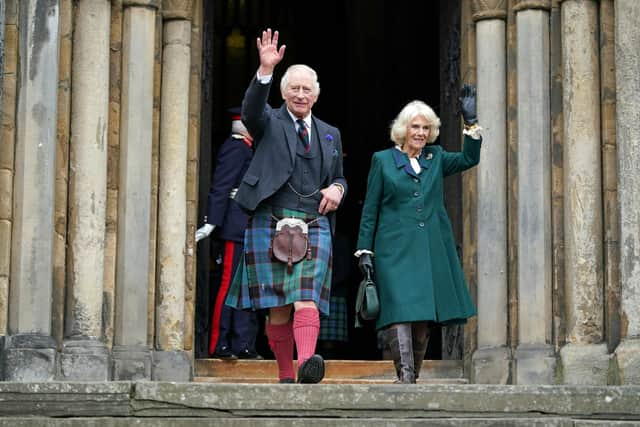Meet the former Royal Correspondent who has written a book about the monarchy


There’s a top tip from writer Stephen Bates for any journalist who wants to have a conversation with one of the Royal Family. Stephen, who used to be the Royal Correspondent for The Guardian newspaper says: “Go and stand in the crowd, when whoever it may be is doing a walkabout – you’ve got a far better chance of being spoken to! The Royals are, perhaps rightly, very wary indeed of the press.
“I was contacted by a delightful man from Arkansas last year, a fellow journalist, and he and his wife are complete anglophiles. He was interested to talk to me about my time covering the Royals – I was lucky enough to go on several overseas tours – and then he told me that they were returning to the UK this year, because they wanted to visit Westminster Abbey, and to see the ceremony of the Royal Maundy money in York. I said that they could always think about getting in touch with whoever handled the invitations for the Yorkshire event, but I doubted that they’d be lucky enough to get a seat in the Minister itself. Naturally, they were rather unhappy when I was proved exactly right.
Advertisement
Hide AdAdvertisement
Hide Ad“But they took on board what I’d said about standing in the crowds and, do you know what? They did indeed have a chat with Charles and Camilla, who came over to them, and had a very nice conversation. As a journalist, you often get your little story from someone from the crowd who has been approached and engaged with the small talk.”


Stephen, 69, lives in Deal, in Kent, and has been a writer all his life. Now freelance, he’s a prolific author, and his book The Shortest History of the Crown has just been issued in paperback to coincide with the King’s Coronation. It looks at the lives of all the kings and queens that this nation has had, from the times of the Angles all the way through to the present day. “There have been good monarchs, bad monarchs, tyrannical monarchs, weak monarchs, mad monarchs, monarchs young and old. Diligent and negligent ones, monarchs who have attempted (largely without success) to break the constitutional settlement, monarchs who have changed the religious order, those who have tried to usurp parliament, those who have been politically partisan, others who have tried to annexe power.
“But more than 330 years have passed since a monarch was ousted, more than 300 since one vetoed legislation, and 180 years since one tried to change the government. Even as their power and influence has waned, their image has become and remained ubiquitous. It’s stamped on everything from coins and banknotes to novelty tea towels and mugs. And people still turn out to see them – for all sorts of reasons. One of the tours I did was to Canada, when Prince William and Kate were the ‘stars of the show.’ It was amazing to learn that, when they were in Ottawa, a million people lined the streets to see them. I went up to someone in the crowd, and I was genuinely interested in why the turn-out was so large. They told me: ‘Well, it’s something that the Americans just don’t have!’”
If you believe that the informal walkabouts date back a mere decade or so, then think again. “Elizabeth I was probably the first to do them,” says Stephen, “when she did one of her many ‘progresses’ up and down her kingdom. She wanted to be seen, and she wanted to meet her people. It was her way of showing them that she existed, that she cared about her subjects.” Not all monarchs trying out a walkabout have equalled Elizabeth’s success. William IV, who had a relaxed attitude to life before he succeeded to the throne, thought that having an impromptu stroll in the centre of London wouldn’t present much of a problem. He was proved horribly wrong. Someone instantly recognised him, and he found himself being caressed by a local sex worker. His Majesty had to be rescued from the mob (and the lady) and he had to seek refuge in the nearby gentlemen’s club, Whites. “How he thought that he could get away with it is anyone’s guess,” laughs Stephen, “he was instantly recognisable because of the shape of his head, and his crest of white hair. His nickname was ‘The Pineapple’”.
Advertisement
Hide AdAdvertisement
Hide AdWilliam was one of our many Kings who enjoyed the company of the ladies – in his case, one in particular, the actress Mrs Dorothea Jordan, with whom he had no less than ten illegitimate children. He only got married (to Queen Adelaide) when the prospect of being King drew closer. They had two little girls, but sadly, they died in infancy, and that paved the way for Victoria to ascend the throne. William’s sexual prowess, reveals Stephen, was only outclassed by that of Henry I who (it is estimated) had 22 children by six mistresses. His only legitimate son was drowned in a tragic accident when he was 17. In the last century, Edward VII had a reputation for being someone who enjoyed female company, especially the ladies of Paris, but Stephen believes that he only produced one child outside his marriage to his long-suffering consort Alexandra. “I wouldn’t be a bit surprised if there are today a few rather rotund gentlemen with impressive side-whiskers tottering around France somewhere who are completely unaware of their ancestry.”
Of the long list of our Kings and Queens, Stephen has three favourites. Elizabeth II, her father George VI, and her grandfather George V. “She had only one concern, her duty to her country and to the Commonwealth. George V was dull, but diligent, someone who people could relate to, as being something like them. He collected stamps, and built up a collection which is today worth over £100 million on the open market. One of his courtiers said to him one day: ‘Sir, did you see in today’s paper that some idiot has paid £1000 for a stamp?’, there was a pause, and the King replied: ‘Yes. It was me.’ I have so much admiration for George VI, because he was the man who never wanted to be King, but had the crown pushed on him because of the behaviour of his wastrel brother, a selfish and dangerous man, who was a complete waste of space.”
Generally, Stephen is kind to the present generation of the House of Windsor – apart from the one he calls “‘Air miles Andy,’ with a misplaced sense of entitlement”. What marks out our new King? “He’s had more training for kingship than any of his ancestors, and he knows the survival techniques of 21st century monarch. Adapt. Compromise. Be seen. Intrusive though it is, publicity is the price that the monarchy must pay for its popularity and endurance. Mind you, some have understood that better than others!”
Stephen won’t himself be in the Abbey for the Coronation today, but will be found sitting “in my favourite comfortable armchair, watching it all on TV. And I know from my own experience that, even if I were in the Abbey, I wouldn’t have had a very good view. The press are always kept in an area next to Poet’s Corner, and there’s the choir between them and all the action. Ironically, the only way we really see what is happening is by watching it all on the specially installed big screens – all we can really report on is the atmosphere of the place.”
The Shortest History of The Crown, by Stephen Bates, Old Street Publishing, £7.19 from Amazon.